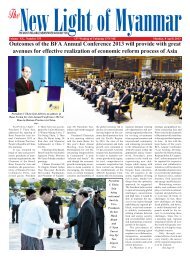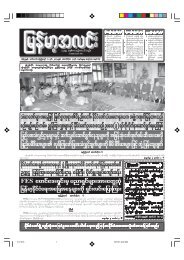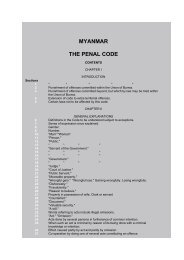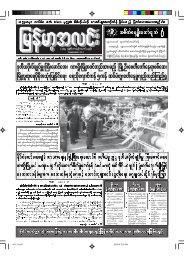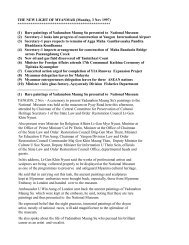Changing Buddhist Practice in Burma - Online Burma Library
Changing Buddhist Practice in Burma - Online Burma Library
Changing Buddhist Practice in Burma - Online Burma Library
You also want an ePaper? Increase the reach of your titles
YUMPU automatically turns print PDFs into web optimized ePapers that Google loves.
Endnotes<br />
I Also known variously as the Mahasi Meditation Centre or Mahasi Retreat <strong>in</strong> English, and Mahasi<br />
Thathana Yeikthar or Thathana Yeikthar <strong>in</strong> Burmese. Literally, yeik <strong>in</strong> Burmese means shade and tak<strong>in</strong>g<br />
refuge, and thar means bliss, happ<strong>in</strong>ess, delight, clarity, and clairvoyance: hence, Yeikthar is translated as<br />
'retreat'. Also, the various meditation centres around <strong>Burma</strong> that are affiliated to and follow the Mahasi<br />
tradition have their own centre names.<br />
Sasana <strong>in</strong> Pali is Thathana <strong>in</strong> Burmese which means 'order, message, teach<strong>in</strong>g' (of Buddha) (Davids<br />
and Stede 1972: 707). Buddha Thathana means Buddha's teach<strong>in</strong>g or Buddhism. Nuggaha refers to the<br />
propagation and promot<strong>in</strong>g of Buddhism.<br />
3 The location of the Mahasi Meditation Centre is No. 16, Thathana Yeiktha Road, Bahan, Rangoon<br />
(Yangon), 11201 <strong>Burma</strong> (Myanmar).<br />
4 Formerly, the country was known to <strong>in</strong>ternational communities <strong>in</strong> English as <strong>Burma</strong>. In 1989,<br />
accord<strong>in</strong>g to the United Nations, the government of <strong>Burma</strong> changed the name from '<strong>Burma</strong>' to<br />
'Myanmar'. Myanmar or Myanmar Na<strong>in</strong>g Ngan (where Na<strong>in</strong>g Ngan means country) is the term the<br />
peoples <strong>in</strong> <strong>Burma</strong> used to call their country long before colonial <strong>in</strong>fluence. The country of <strong>Burma</strong> is<br />
known commonly as 'Union of <strong>Burma</strong>' or 'Pyi Thung Zu Myanmar Na<strong>in</strong>g Ngan Daw' <strong>in</strong> Burmese, which<br />
literally can be translated as the 'union of thousand nations'. Also, Bamar, unlike <strong>Burma</strong>, refers to the<br />
ethnic Bamar who made up the majority of the populace. Houtman (1990: 266, <strong>in</strong>dex of terms <strong>in</strong><br />
endnotes) uses the term Burmese for all those who speak the Burmese language.<br />
5 In the past, the various ethnic communities tended to group together and lived <strong>in</strong> specific parts of the<br />
country. The ethnic <strong>Burma</strong>n tended to live <strong>in</strong> the lowland regions and others, such as Arakan, Mon, Shan,<br />
Karen, Karenni, and Kach<strong>in</strong>, and many smaller ethnic group<strong>in</strong>gs, tended to live <strong>in</strong> highland regions. In<br />
the contemporary period, they have become <strong>in</strong>creas<strong>in</strong>gly <strong>in</strong>term<strong>in</strong>gled, <strong>in</strong>teract<strong>in</strong>g socially and culturally<br />
with each other, and many of them are now concentrated <strong>in</strong> urban areas.<br />
See also Houtman (1990a), "How a foreigner <strong>in</strong>vented 'Buddhendom' <strong>in</strong> Burmese: from Tha-tha-na to<br />
Bok-da' ba-tha", for some historical accounts about terms such as Buddha Tha Tha Na <strong>in</strong> Burmese (or<br />
Buddha Sasana <strong>in</strong> Pali) and Bok-da' ba-tha which denotes the cultural dimension of Buddhism (Houtman<br />
1990: 114-7). Also, ba-tha can mean language, race, or subject, eg. Mathematics, Biology, etc.<br />
7 Other major religions <strong>in</strong> <strong>Burma</strong> <strong>in</strong>clude Christianity, H<strong>in</strong>duism, and Islam, and a few <strong>in</strong>digenous belief<br />
systems. See also Houtman (1990: 36).<br />
8 Parami (P, S) “'perfections'; virtues and faculties required for the atta<strong>in</strong>ment of Buddhahood"<br />
(Nyanaponika Thera 1962: 215).<br />
9 See Jordt (2001: 6) for details.<br />
10 The noble truth of suffer<strong>in</strong>g: birth, old age, death, sorrow, lamentation, pa<strong>in</strong>, grief and despair, and not<br />
to get what one wishes, all of these five aggregates of cl<strong>in</strong>g<strong>in</strong>g are suffer<strong>in</strong>g (Nyanaponika Thera 1962:<br />
127-8).<br />
II The noble truth of the cessation of suffer<strong>in</strong>g: "It is that crav<strong>in</strong>g gives rise to fresh rebirth, and, bound<br />
up with pleasure and lust, f<strong>in</strong>ds ever fresh delight, now here, now there - to wit, the Sensual Crav<strong>in</strong>g, the<br />
Crav<strong>in</strong>g for (Eternal) Existence and the Crav<strong>in</strong>g for Non-Existence" and the crav<strong>in</strong>g arises and takes root<br />
<strong>in</strong> delightful and pleasurable senses of eye, ear, nose, tongue, visual forms, sounds, smells, tastes, eyeconsciousness,<br />
ear-consciousness, nose-consciousness, tongue-consciousness, body-consciousness, and<br />
m<strong>in</strong>d-consciousness (Nyanaponika Thera 1962: 128-9).<br />
12 The noble truth of the cessation of suffer<strong>in</strong>g is "the complete fad<strong>in</strong>g away and ext<strong>in</strong>ction of this very<br />
crav<strong>in</strong>g" and this crav<strong>in</strong>g of body-m<strong>in</strong>d may be abandoned and ext<strong>in</strong>guished (Nyanaponika Thera 1962:<br />
129).<br />
13 The noble truth of the path lead<strong>in</strong>g to the cessation of suffer<strong>in</strong>g is the "Noble Eightfold Path, namely,<br />
[1] Right Understand<strong>in</strong>g about suffer<strong>in</strong>g, the orig<strong>in</strong> of suffer<strong>in</strong>g, the cessation of suffer<strong>in</strong>g, and the path<br />
lead<strong>in</strong>g to the cessation of suffer<strong>in</strong>g, [2] Right Thought that are free from lust, ill-will, and cruelty, [3]<br />
Right Speech is to absta<strong>in</strong> from ly<strong>in</strong>g, tale-bear<strong>in</strong>g, harsh speech, and va<strong>in</strong> talk, [4] Right Action is to<br />
absta<strong>in</strong> from kill<strong>in</strong>g, tak<strong>in</strong>g what is not given, and adultery, [5] Right Livelihood is "When the noble<br />
disciple, avoid<strong>in</strong>g a wrong way of livelihood, gets his livelihood by a right way of liv<strong>in</strong>g", [6] Right<br />
Effort: "Here<strong>in</strong> a monk rouses his will to avoid [and overcome] the aris<strong>in</strong>g of evil, unsalutary states, he<br />
makes effort, stirs up his energy, applies his m<strong>in</strong>d to it and strives", [7] Right M<strong>in</strong>dfulness: "Here<strong>in</strong> a<br />
monk dwells practis<strong>in</strong>g body-contemplation on the body - practis<strong>in</strong>g feel<strong>in</strong>g-contemplation on feel<strong>in</strong>gs -<br />
practis<strong>in</strong>g m<strong>in</strong>d-contemplation on the m<strong>in</strong>d - practis<strong>in</strong>g m<strong>in</strong>d-object-contemplation on m<strong>in</strong>d-objects,<br />
ardent, clearly comprehend<strong>in</strong>g and m<strong>in</strong>dful, hav<strong>in</strong>g overcome covetousness and grief concern<strong>in</strong>g the<br />
world", [8] Right Concentration: "Here<strong>in</strong> a monk detached from sensual objects, detached from<br />
unsalutary th<strong>in</strong>gs, enters <strong>in</strong>to the first absorption, born of detachment, accompanied by thoughconception<br />
and discursive thought, and filled with rapture and joy. After the subsid<strong>in</strong>g of thoughconception<br />
and discursive thought, and by ga<strong>in</strong><strong>in</strong>g <strong>in</strong>ner tranquillity and oneness of m<strong>in</strong>d, he enters <strong>in</strong>to a<br />
state free from thought-conception and discursive thought, the second absorption, which is born of<br />
22







